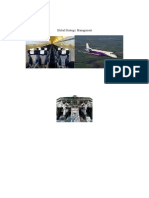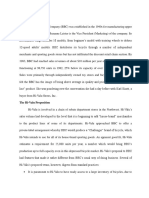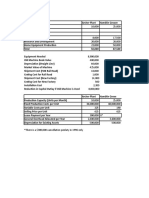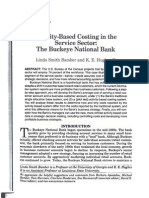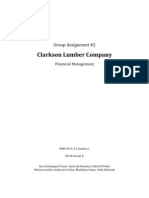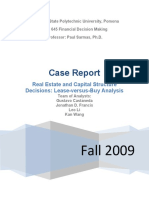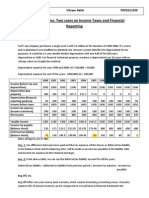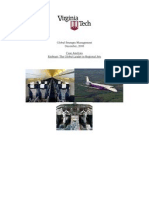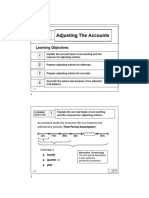Taxing Situations Two Cases On Income Taxes - An Accounting Case Study
Taxing Situations Two Cases On Income Taxes - An Accounting Case Study
Uploaded by
fossacecaCopyright:
Available Formats
Taxing Situations Two Cases On Income Taxes - An Accounting Case Study
Taxing Situations Two Cases On Income Taxes - An Accounting Case Study
Uploaded by
fossacecaOriginal Title
Copyright
Available Formats
Share this document
Read this document in other languages
Did you find this document useful?
Is this content inappropriate?
Copyright:
Available Formats
Taxing Situations Two Cases On Income Taxes - An Accounting Case Study
Taxing Situations Two Cases On Income Taxes - An Accounting Case Study
Uploaded by
fossacecaCopyright:
Available Formats
Taxing Situations: Two Cases on Income Taxes and Financial Reporting
Surfs Up
1. Assuming no additional new equipment is acquired, how should the difference between taxes paid and the tax expense shown in the pro forma income
statements be reported, if at all?
The company earns $1,500,000 before depreciation and tax. Surfs Up buys buys equipment for $1,000,000 and depreciates it straight line(modified) for reporting
purposes over 10 years. For tax purposes, MACRS schedule is used as provided in exhibit 1. Depreciation for the first year is $1,000,000 x 1/10 x 1/2 = $50,000
(Note: the factor is for the first year as cited in the case). Depreciation for the first year (1990) is given as $200,000 in exhibit 1. For Reporting purposes, Income
is $1,500,000 - $50,000 = $1,450,000. Taxable income is $1,500,000-$200,000 = $1,300,000. With a tax rate of 40%, the taxes payable are $1,300,000 x .40 =
$520,000. Therefore, the deferred tax liability is ($200,000 - $50,000) x .40 = $60,000. Income tax expense is $520,000+$60,000 = $580,000. The income tax note
to the financial statements is as follows:
Income tax:
Current
$520,000
Deferred
$ 60,000
Tax expense $580,000
The tax expense of $580,000 is reported on the income statement.
Income before tax
$1,450,000
Income tax expense
580,000
Net income
$870,000
The deferred tax liability of $60,000 is reported on the balance sheet. This account will increase in the second year, because depreciation for tax purposes
($320,000 exhibit 1) will exceed depreciation for accounting purposes ($100,000). Note: Straight Line Depreciation is shown as stated in the case where for year
1990, only of the depreciation amount is taken.
Tax Depreciation
Worksheet
Year
Straight
MACRS
Difference
1990
50000
200000
150000
1991
100000
320000
220000
1992
100000
192000
92000
1993
100000
115200
15200
1994
100000
115200
15200
1995
100000
57600
-42400
1996
100000
-100000
1997
100000
-100000
1998
100000
-100000
1999
100000
-100000
2000
50000
Total
1000000
-50000
1000000
Taxing Situations: Two Cases on Income Taxes and Financial Reporting
Income Statement
Years
1990
1991
1992
1993
1994
1995
1996
1997
1998
1999
2000
$1,500,000
$1,500,000
$1,500,000
$1,500,000
$1,500,000
$1,500,000
$1,500,000
$1,500,000
$1,500,000
$1,500,000
$1,500,000
$16,500,000
$50,000
$100,000
$100,000
$100,000
$100,000
$100,000
$100,000
$100,000
$100,000.00
$100,000
$50,000
$1,000,000
$200,000
$320,000
$192,000
$115,200
$115,200
$57,600
$0
$0
$0
$0
$0
$1,000,000
$1,450,000
$1,400,000
$1,400,000
$1,400,000
$1,400,000
$1,400,000
$1,400,000
$1,400,000
$1,400,000
$1,400,000
$1,450,000
$580,000
$560,000
$560,000
$560,000
$560,000
$560,000
$560,000
$560,000
$560,000
$560,000
$580,000
$6,200,000
$520,000
$472,000
$523,200
$553,920
$553,920
$576,960
$600,000.00
$600,000
$600,000
$600,000
$600,000
$6,200,000
Deferred
Income Tax
$60,000
$88,000
$36,800
$6,080
$6,080
($16,960.00)
($40,000)
($40,000)
($40,000)
($40,000)
($20,000)
$0
Net Income
$870,000
$840,000
$840,000
$840,000
$840,000
$840,000.00
$840,000
$840,000
$840,000
$840,000
$870,000
$9,300,000
Net Rev
Before
Tax/Dep
Straight Line
Depreciation
(Modified)
MACRS
Depreciation
Net
Revenue
Before Tax
Income Tax
Expense
Income Tax
Actual
All
2. What will be the balance in the deferred tax liability account in Surfs Ups Statement of Financial Position at the end of 1991? 1995? 2000?
As can be seen above the balance in the deferred tax liability account in Surfs Up Balance Sheet will be:
1990
1991
1992
1993
1994
1995
1996
1997
1998
Defererred Tax
Liability Beg.
Balance
Period Change
Ending Balance
$60,000
$60,000
$60,000
$88,000
$148,000
$148,000
$36,800
$184,800
$184,800
$6,080
$190,880
$190,880
$6,080
$196,960
Notice that in 2000 the balance is Zero as expected.
$196,960
($16,960)
$180,000
$180,000
($40,000)
$140,000
$140,000
($40,000)
$100,000
$100,000
($40,000)
$60,000
1999
$60,000
($40,000)
$20,000
2000
$20,000
($20,000)
-
Taxing Situations: Two Cases on Income Taxes and Financial Reporting
Bug Off, Inc.
1. Prepare pro forma income statements for Bug Off, Inc., for 1990 through 1992 as they will appear in financial reports and in the
companys income tax returns. How do you account for the difference in taxes occasioned by the difference in accounting for warranty
expense in the accrual method financial reports and in the companys tax returns?
Warranty expenses are shown on the income statement as reduced earnings, however taxes are not treated in the same manner. When a
tax is paid in one year that should be matched against income of a later period, the tax charge is set aside until the proper time for
appearance in the income statement. Therefore, the tax is said to be deferred.
According to standard accounting and IRS regulations, the warranty expenses can be deducted for tax purposes only as these expenses
are actually incurred. However, since the exact warranty expense is not known until the customer requests the warranty service, it must
be estimated. In the case of Bug Off, Inc. this is estimated as 6% of sales. The percentage is derived from past experience.
Journal entry to accrue warranty expense:
Warranty expense
Estimated Warranty Payable
Sales * .06
Sales * .06
Journal entry for taxes (40% tax rate):
Prepaid (Deferred) Income Tax Charge
Income Tax Expense
(Note:To reduce tax expense, treat as prepaid 40%
of the amount accrued as warranty expense not
currently tax deductible)
.40*Sales*.06
.40 *Sales*.06
Taxing Situations: Two Cases on Income Taxes and Financial Reporting
Book Income
Revenues
1990
$200,000
1991
$100,000
1992
$100,000
Expenses
Materials
Salaries
Depreciation
Warranty Acrrual
Total
$50,000
$55,000
$5,000
$12,000
$122,000
$25,000
$35,000
$5,000
$6,000
$71,000
$25,000
$35,000
$5,000
$6,000
$71,000
Income before Taxes
$78,000
$29,000
$29,000
Tax Rate
40.00%
40.00%
40.00%
Taxes Expense
$31,200
$11,600
$11,600
Net Income
$46,800
$17,400
$17,400
Revenues
1990
$200,000
1991
$100,000
1992
$100,000
Expenses
Materials
Salaries
Depreciation
Warranty Expenditure
Total
$50,000
$55,000
$5,000
$6,000
$116,000
$25,000
$35,000
$5,000
$12,000
$77,000
$25,000
$35,000
$5,000
$6,000
$71,000
$84,000
$23,000
$29,000
Tax Income
Income before Taxes
54,400
Taxing Situations: Two Cases on Income Taxes and Financial Reporting
Tax Rate
40.00%
40.00%
40.00%
Taxes Expense
$33,600
$9,200
$11,600
Net Income
$50,400
$13,800
$17,400
54,400
2. How should the deferred taxes be reported in Bug Offs Statement of Financial Position in each year?
According to the asset and liability approach prescribed by FASB 109, the amount of deferred tax assets and liabilities are computed
annually and placed on the balance sheet.
Warranty Reserve - Balance Sheet Item
Begin. Balance
$6,000
Warranty Accrual
$12,000
Warranty Expenditure
($6,000)
Ending Balance
$12,000
Deferred Taxes - Balance Sheet Item
Book Taxes
$31,200
Taxes Paid
$33,600
Deferred Taxes
($2,400)
$12,000
$6,000
($12,000)
$6,000
$6,000
$6,000
($6,000)
$6,000
$11,600
$9,200
$2,400
$11,600
$11,600
-
References and Data Sources
Proposed Interpretation of Statement of Financial Accounting Standards No. 109 (FASB 2005)
You might also like
- Baldwin Bicycle Company - Final Assignment - Group F - 20210728No ratings yetBaldwin Bicycle Company - Final Assignment - Group F - 202107284 pages
- Baldwin Bicycle Analysis (ImranGreenSlide)No ratings yetBaldwin Bicycle Analysis (ImranGreenSlide)20 pages
- Rougir Cosmetics International Did Not Have Internal Capacity To Meet Demand100% (1)Rougir Cosmetics International Did Not Have Internal Capacity To Meet Demand3 pages
- Technology Operations & Management Case: Mcleod Motors Ltd. WAC Submission100% (2)Technology Operations & Management Case: Mcleod Motors Ltd. WAC Submission6 pages
- Operations Strategy - FPL Quality Improvement Case100% (4)Operations Strategy - FPL Quality Improvement Case13 pages
- Goup 11 Baldwin Bicycle Company Case Presntation100% (1)Goup 11 Baldwin Bicycle Company Case Presntation20 pages
- Cindy Lota - Activity No. 4 - SFP Antonio Trading100% (2)Cindy Lota - Activity No. 4 - SFP Antonio Trading5 pages
- GBA 645 Case7 Real Estate and Capital Structure DecisionsNo ratings yetGBA 645 Case7 Real Estate and Capital Structure Decisions6 pages
- Baguette Galore International Ppts FinalNo ratings yetBaguette Galore International Ppts Final23 pages
- PIA Hawaii Emirates Easy Jet: Breakeven AnalysisNo ratings yetPIA Hawaii Emirates Easy Jet: Breakeven Analysis3 pages
- Baldwin Case Analysis - Kanupriya ChaudharyNo ratings yetBaldwin Case Analysis - Kanupriya Chaudhary4 pages
- Miles High Cycles Katherine Roland and John ConnorsNo ratings yetMiles High Cycles Katherine Roland and John Connors4 pages
- Logistic & Distribution Management: Lotus Thread Company LTDNo ratings yetLogistic & Distribution Management: Lotus Thread Company LTD6 pages
- F1 Financial Operations Questions and Answers From Past Ask A Tutor' Events - Archived by Syllabus AreaNo ratings yetF1 Financial Operations Questions and Answers From Past Ask A Tutor' Events - Archived by Syllabus Area13 pages
- Week 2 - Linear Programming: Formulation and Applications & "What-If" AnalysisNo ratings yetWeek 2 - Linear Programming: Formulation and Applications & "What-If" Analysis95 pages
- MGMT 101: Introduction To Management Science: Fall (October - December) 2012No ratings yetMGMT 101: Introduction To Management Science: Fall (October - December) 20124 pages
- Week 3 - "What-If" Analysis For Linear Programming and Intro To Network Optimization ProblemsNo ratings yetWeek 3 - "What-If" Analysis For Linear Programming and Intro To Network Optimization Problems62 pages
- Lecture 1 EMSE 6850 - Quantitative Models For Systems EngineersNo ratings yetLecture 1 EMSE 6850 - Quantitative Models For Systems Engineers89 pages
- A Workshop Designed To Expose Basic Accounting Principles To Future Micro-Entrepreneurs in The PhilippinesNo ratings yetA Workshop Designed To Expose Basic Accounting Principles To Future Micro-Entrepreneurs in The Philippines26 pages
- Nama: Aliea Yenemia Putri NPM: 120110210003 P4-19 A. Randy & Wiskers Enterprises Pro Forma Balance Sheet December 31, 2019 Assets Liabilities and Stockholders' EquityNo ratings yetNama: Aliea Yenemia Putri NPM: 120110210003 P4-19 A. Randy & Wiskers Enterprises Pro Forma Balance Sheet December 31, 2019 Assets Liabilities and Stockholders' Equity10 pages
- Chapter 22 - Gripping IFRS ICAP 2008 (Solution of Graded Questions)100% (1)Chapter 22 - Gripping IFRS ICAP 2008 (Solution of Graded Questions)26 pages
- Conceptual Frameworks For Accounting Standards I - Chapter 1No ratings yetConceptual Frameworks For Accounting Standards I - Chapter 13 pages
- AcFN 3151 CH, 5 CONSOLIDATED FINANCIAL STATEMENTS IFRS 10100% (1)AcFN 3151 CH, 5 CONSOLIDATED FINANCIAL STATEMENTS IFRS 1041 pages
- 6352 Discontinued Operation and Noncurrent Asset Held For SaleNo ratings yet6352 Discontinued Operation and Noncurrent Asset Held For Sale3 pages
- A Compilation of Case Studies in Financial AccountingNo ratings yetA Compilation of Case Studies in Financial Accounting75 pages
- Answers and Solutions To Additional Exercises Problem 1No ratings yetAnswers and Solutions To Additional Exercises Problem 122 pages
- Baldwin Bicycle Company - Final Assignment - Group F - 20210728Baldwin Bicycle Company - Final Assignment - Group F - 20210728
- Rougir Cosmetics International Did Not Have Internal Capacity To Meet DemandRougir Cosmetics International Did Not Have Internal Capacity To Meet Demand
- Technology Operations & Management Case: Mcleod Motors Ltd. WAC SubmissionTechnology Operations & Management Case: Mcleod Motors Ltd. WAC Submission
- Operations Strategy - FPL Quality Improvement CaseOperations Strategy - FPL Quality Improvement Case
- GBA 645 Case7 Real Estate and Capital Structure DecisionsGBA 645 Case7 Real Estate and Capital Structure Decisions
- Miles High Cycles Katherine Roland and John ConnorsMiles High Cycles Katherine Roland and John Connors
- Logistic & Distribution Management: Lotus Thread Company LTDLogistic & Distribution Management: Lotus Thread Company LTD
- F1 Financial Operations Questions and Answers From Past Ask A Tutor' Events - Archived by Syllabus AreaF1 Financial Operations Questions and Answers From Past Ask A Tutor' Events - Archived by Syllabus Area
- Week 2 - Linear Programming: Formulation and Applications & "What-If" AnalysisWeek 2 - Linear Programming: Formulation and Applications & "What-If" Analysis
- MGMT 101: Introduction To Management Science: Fall (October - December) 2012MGMT 101: Introduction To Management Science: Fall (October - December) 2012
- Week 3 - "What-If" Analysis For Linear Programming and Intro To Network Optimization ProblemsWeek 3 - "What-If" Analysis For Linear Programming and Intro To Network Optimization Problems
- Lecture 1 EMSE 6850 - Quantitative Models For Systems EngineersLecture 1 EMSE 6850 - Quantitative Models For Systems Engineers
- A Workshop Designed To Expose Basic Accounting Principles To Future Micro-Entrepreneurs in The PhilippinesA Workshop Designed To Expose Basic Accounting Principles To Future Micro-Entrepreneurs in The Philippines
- Nama: Aliea Yenemia Putri NPM: 120110210003 P4-19 A. Randy & Wiskers Enterprises Pro Forma Balance Sheet December 31, 2019 Assets Liabilities and Stockholders' EquityNama: Aliea Yenemia Putri NPM: 120110210003 P4-19 A. Randy & Wiskers Enterprises Pro Forma Balance Sheet December 31, 2019 Assets Liabilities and Stockholders' Equity
- Chapter 22 - Gripping IFRS ICAP 2008 (Solution of Graded Questions)Chapter 22 - Gripping IFRS ICAP 2008 (Solution of Graded Questions)
- Conceptual Frameworks For Accounting Standards I - Chapter 1Conceptual Frameworks For Accounting Standards I - Chapter 1
- AcFN 3151 CH, 5 CONSOLIDATED FINANCIAL STATEMENTS IFRS 10AcFN 3151 CH, 5 CONSOLIDATED FINANCIAL STATEMENTS IFRS 10
- 6352 Discontinued Operation and Noncurrent Asset Held For Sale6352 Discontinued Operation and Noncurrent Asset Held For Sale
- A Compilation of Case Studies in Financial AccountingA Compilation of Case Studies in Financial Accounting
- Answers and Solutions To Additional Exercises Problem 1Answers and Solutions To Additional Exercises Problem 1




